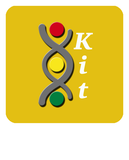Catalog # PK7690
p38 MAPK Phospho-Regulation Staining Kit
Immunocytochemistry Kit
| ELISA, WB, ICC, IHC |
Species Reactivity
| Hu, Rt, Ms, Ck, Rb |
 |
KIT SUMMARY The p38 MAPK phospho-regulation kit can be used for immunocytochemical co-localization of p38 MAPK phosphorylation at Thr-180/Tyr-182 and Tyr-323 relative to the total expression of p38 MAPK. The kit includes rabbit polyclonal and mouse monoclonal antibodies along with Goat-anti-Rabbit conjugated to DyLight® 594 and Goat anti-Mouse conjugated to DyLight® 488 for dual labeling experiments. |

Immunocytochemical labeling of p38 MAPK in control and pervanadate-treated mouse C2C12 cells. The cells were labeled with mouse monoclonal p38α MAPK (PM1381), p38 MAPK (Thr-180/Tyr-182) (PM1391), and rabbit polyclonal p38 MAPK (Tyr-323) (PP3411). The antibodies were detected using appropriate secondary conjugated to DyLight® 488 or DyLight® 594.
The products are are safely shipped at ambient temperature for both domestic and international shipments. Each product is guaranteed to match the specifications as indicated on the corresponding technical data sheet. Please store at -20C upon arrival for long term storage.
*All molecular weights (MW) are confirmed by comparison to Bio-Rad Rainbow Markers and to western blot mobilities of known proteins with similar MW.
Product References:
PP3411 Alam, M.S. et al. (2015) Nat Medicine 21:1337. WB, IF: human T-cells, CD3 activatedPP3411 Lanna, A. et al. (2014) Nat Immunol. 15(10):965. WB: human T-cells, CD3 activated
PM1391 Chambers, M.A. et al. (2009) J Physiol. 587:3363. WB: mouse muscle, C2C12
PM1391 Li, W. et al. (2009) AJP Cell Phys. 297:C706. WB: mouse C2C12 cells
This kit contains:
| CATALOG# | DESCRIPTION | SIZE | APPLICATIONS | SPECIES REACTIVITY | ICC DILUTION |
| p38α MAP Kinase (C-terminal) Mouse mAb | 50 μl | WB, E, ICC | Hu, Rt, Ms | 1:200 | |
| p38 MAP Kinase (Thr-180/Tyr-182), phospho-specific Mouse mAb | 50 μl | WB, E, ICC | Hu, Rt, Ms | 1:250 | |
| p38α MAP Kinase (Tyr-323), phospho-specific Rabbit pAb | 50 μl | WB, E, ICC | Hu, Rt, Ms, Ck | 1:300 | |
| Anti-Mouse Ig:DyLight® 488 Goat pAb | 100 μl | ICC, IHC | Ms | 1:200 | |
| Anti-Rabbit Ig:DyLight® 594 Goat pAb | 100 μl | ICC, IHC | Rb | 1:200 |



















































